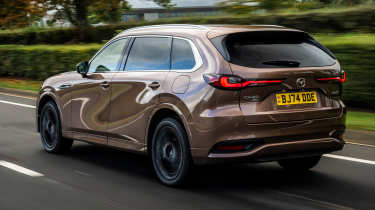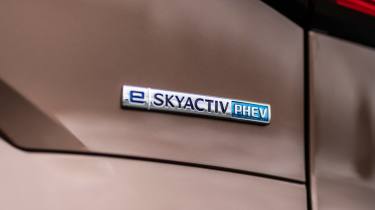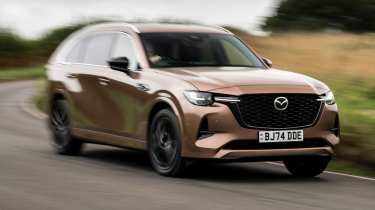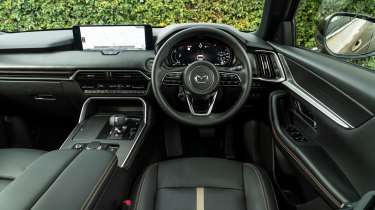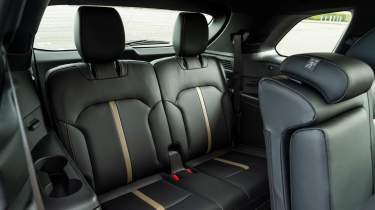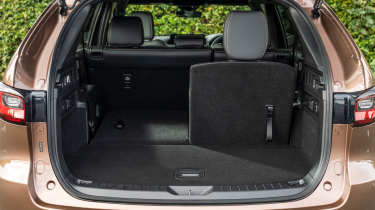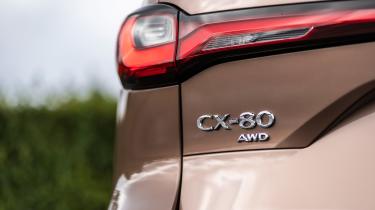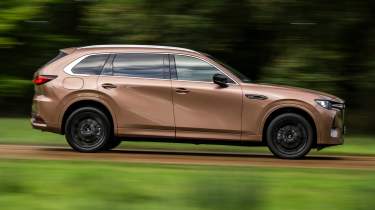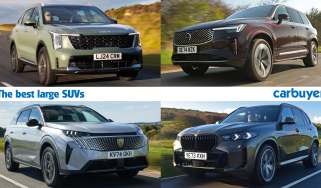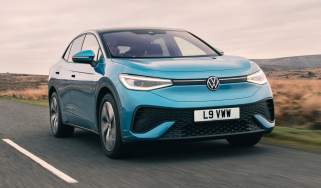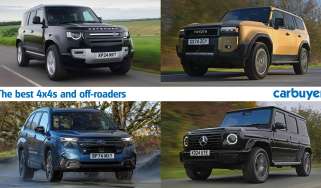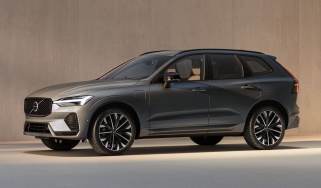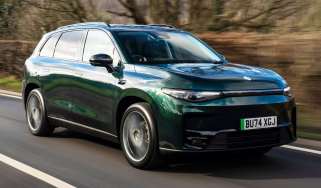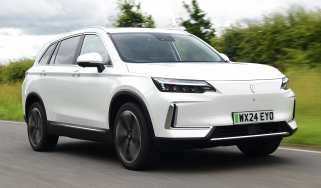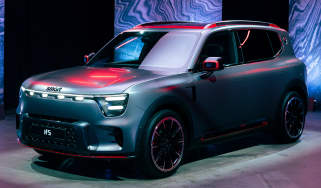Mazda CX-80 review – spacious seven-seat diesel or plug-in hybrid SUV
“The Mazda CX-80 is a surprising new entry into the seven-seat SUV arena, with a spacious interior and either a PHEV or a six-cylinder diesel engine”
Pros
- Decent third-row space
- Efficient engines
- Intuitive and attractive interior
Cons
- Slightly firm ride
- PHEV can be hesitant
- Conservative interior tech
Verdict – is the Mazda CX-80 a good car?
If you’ve been considering a large seven-seat family SUV, the Mazda CX-80 is a compelling new entry. For starters, its third row is actually spacious enough for adults, and it also has a tremendous boot when you don’t need them. A new six-cylinder diesel engine might seem like an odd choice, but clever engineering means it’s more efficient and better to drive than rivals with smaller diesel engines. If a diesel doesn’t fit the bill for you, there’s also a plug-in hybrid with a middling electric-only driving range.
Mazda CX-80 models, specs and alternatives
Mazda has taken the plunge and released its first large seven-seat family SUV. The CX-80 is within a fingernail of five metres in length, so even tall adults can fit into its third row of seats. Unlike the majority of clean-sheet designs, it also sticks with combustion engines, whether you pick Mazda’s plug-in hybrid (PHEV) or its new 3.3-litre diesel engine.
While big seven-seat SUVs aren’t as commonplace in the UK as small and mid-size SUVs, it still goes up against quite a few rivals. There’s the recently-launched Hyundai Santa Fe and Kia Sorento, both of which feature striking designs, along with the SEAT Tarraco, Nissan X-Trail and Skoda Kodiaq. The Mazda is reasonably well-priced too, costing from just under £49,000 – slightly less than both the Kia and Hyundai. While the PHEV is often quite a bit more expensive, it actually undercuts the diesel version here, with equivalent diesels costing around £2,500 more.
That’s likely because Mazda has developed its new six-cylinder diesel engine from scratch, and it gets plenty of innovative new technology – including mild-hybrid electrification – to help make it as efficient as possible. Don’t be put off by its large size, then. Despite being a 3.3-litre, it’s actually more fuel-efficient than the 2.0-litre TDI diesel in the all-wheel drive Skoda Kodiaq. We also found it smooth to drive and it even sounds good.
Company car choosers will likely be swayed by the low CO2 emissions and 37-mile driving range of the PHEV, though. It’s faster than the diesel on paper, too, although we found its juggling of petrol and electric power wasn’t quite as smooth as in some rivals.
There are no fewer than four trim levels, which seems a bit like overkill in a car like this. Still, it means there aren’t loads of optional extras – you just pick the trim with the goodies you want. Even the entry-level Exclusive Line will be perfectly adequate for the majority of people, and gets niceties like a powered boot and twin 12.3-inch displays across the dashboard. Homura gets a more sporting look thanks to 20-inch black alloy wheels and dark-coloured exterior trim, along with a 12-speaker Bose stereo. Homura Plus does actually add quite a lot of kit, from a 360-degree camera and radar cruise control to a panoramic sunroof and even an electrical socket. The range-topping Takumi ushers in white Nappa leather upholstery and White Maple wooden trim for a more exclusive feel – it really does feel like something special and echoes a more classic premium style with material quality the focus, rather than being tech-heavy.
|
Trim levels |
Power options |
|
|
MPG, running costs & CO2 emissions
As mentioned above, there are just two engines offered in the CX-80; a large diesel – yes, really – and a plug-in hybrid petrol. The newly-developed six-cylinder diesel is likely to be one of the last clean-sheet diesel engines we see as the fuel type appears to be going the way of the dodo, but Mazda’s decision will make a whole heap of sense for a certain type of buyer. Think private customers who want to travel long distances, tow a heavy caravan, or both.
It’s clever too, with 48-volt mild-hybrid technology that Mazda calls ‘M-Hybrid Boost’ that gives the engine an extra 17bhp burst under acceleration to improve efficiency. Not only that, but the engine has egg-shaped combustion chambers and other special tricks to coax nearly 50mpg out of its largest, flagship SUV. It clearly works, because it beats the diesel Kia Sorento’s figure of 42.8mpg and the range-topping Skoda Kodiaq’s 44.2mpg, despite being a considerably larger engine.
Choose the PHEV, and the CX-80 comes with a 2.5-litre petrol engine, an electric motor and a 17.8kWh battery pack. This gives it an electric driving range of up to 37 miles, which is decent, but falls short of the Kodiaq’s impressive 75-mile range. While 7kW charging for the Mazda is fairly typical, and means a full charge should take around 2.5 hours, we’re also starting to see PHEVs with much faster DC charging capabilities.
|
Model |
Fuel economy |
CO2 emissions |
|
Mazda CX-80 PHEV |
176.5mpg |
36g/km |
|
Mazda CX-80 Skyactiv-D |
48.7-49.5mpg |
148-151g/km |
How efficient is the Mazda CX-80 in the real world?
During our test drive of the CX-80 diesel we managed around 46mpg, over a combination of urban, A-road and faster motorway driving. During our test of the PHEV driving at high speeds on the German Autobahn and then at a much slower pace in town traffic, we recorded 68mpg.
How much will the Mazda CX-80 cost in tax?
The diesel will cost the standard annual rate in VED (road tax) from the second year onwards, while the PHEV gets a small £10 discount thanks to its alternative fuel status. That’s not quite the end of the story, though, because every CX-80 costs more than £40,000, making it liable for the VED surcharge levied against luxury cars in renewal years two to six, for a total annual bill closer to £600.
What will the Mazda CX-80 cost to insure?
It doesn’t matter which engine you pick here, because both the diesel and PHEV fall into insurance groups 37 to 39. That compares to groups 20-26 for the Skoda Kodiaq and groups 45 to 49 for the BMW X5.
Engines, drive & performance
Being a large and upmarket SUV, the CX-80 gets a configuration more common to luxury BMW and Mercedes SUVs than the cars we’re used to from the Japanese brand. The CX-80 has its engine mounted lengthways under the bonnet (instead of sideways) and its all-wheel drive is more heavily biased towards the rear axle.
Despite its size, the CX-80 also shares a few things in common with the Mazda MX-5 sports car, with a system Mazda calls Kinematic Posture Control (KPC) that helps improve body control during dynamic driving. Even Mazda’s SUVs – particularly the Mazda CX-5 – have garnered a great reputation for being engaging to drive, and the CX-80 does share some of these traits, with pleasant steering feel and balance. However, this has come at the cost of ride quality to an extent, which feels slightly jittery even on smooth roads. Given the CX-80’s size and customers, a more comfort-focused ride could have given the biggest Mazda a unique character within the lineup.
Diesel models
Its diesel engine also bucks the ‘downsizing’ trend that’s seen most cars get small motors. Measuring 3.3 litres and with six cylinders, along with an additional 17bhp boost from its mild hybrid technology, acceleration has an effortless feel.
With a 0-62mph time of 8.4 seconds it’s not massively fast, but pulling power feels almost seamless as the car picks up speed, and rather like six-cylinder versions of the BMW X5, the engine has a smooth character. Its eight-speed automatic gearbox isn’t quite as smooth or clever at shifting at just the right moment as the best rivals, but for the price of the Mazda CX-80 it’s an impressive engine. It will depend on your preference, but as diesels go it sounds quite good, too, with a substantial and grunty sound coming from its six-cylinders.
|
Model |
Power |
0-62mph |
Top speed |
|
Mazda CX-80 Skyactiv-D |
251bhp |
8.4s |
135mph |
Plug-in hybrid models
The CX-80 PHEV couldn’t really be more different from the diesel, packing in a 2.5-litre petrol engine, a 173bhp electric motor and a 17.8kWh lithium-ion battery. When maximum performance is needed and both join forces, there’s up to 323bhp on tap, and the electric motor provides a good surge of acceleration instantly.
It certainly feels quicker than the diesel, with quite a turn of speed given the CX-80’s weight of around two tonnes. The change from petrol to electric power isn’t always quite as seamless as in some rivals, though, and it’s possible to hear a high-pitched whine from the motor at times. We did find that Sport mode makes things smoother, because it prioritises the petrol engine and instead uses the electric motor to augment performance, instead of flip-flopping between the two.
|
Model |
Power |
0-62mph |
Top speed |
|
Mazda CX-80 PHEV |
323bhp |
6.8s |
122mph |
Electric models
We don’t expect to see an all-electric version of the Mazda CX-80, and the Japanese brand only currently makes one EV – the Mazda MX-30 – which is a far smaller SUV. A large and upmarket electric equivalent would be a car like the Audi Q6 e-tron, Mercedes EQB or BMW iX3.
Interior & comfort
The Mazda’s interior design is somewhat conservative in design next to some rivals like the Hyundai Santa Fe, but some buyers will prefer this approach. It also feels suitably upmarket and well put together, and most materials feel sturdy enough for a big family SUV.
It’s worth noting that if you go for a top-spec Takumi trim, this includes a white leather finish with light wooden trim, which gives the cabin an airy and classy feel we think some customers will love. However, the black and tan upholstery of the Homura might prove to be more practical in the long run, and looked just as upmarket to our eyes.
Is the Mazda CX-80 infotainment and sat-nav system easy to use?
No matter which CX-80 you go for, the interior is decked out with the same 12.3-inch infotainment display and a driver’s instrument panel of the same size. Almost uniquely nowadays, neither is a touchscreen, with Mazda instead preferring a rotary dial to control settings. Amazon Alexa voice control also comes from the off, and can be used to control the car’s climate control, air-conditioning and even third-party apps like Spotify. If you’d prefer to use Apple CarPlay or Android Auto, those both also work wirelessly. We appreciate the physical controls for the infotainment, but wish touchscreen functionality was also available, as navigating Apple CarPlay and Android Auto using the dial doesn’t feel quite as natural as it should, especially when stationary.
Key features | |
|
Exclusive Line
|
Homura (Exclusive Line plus…)
|
|
Homura Plus (Homura plus…)
|
Takumi (Homura Plus plus…)
|
Boot space, practicality & dimensions
Measuring just 5mm shy of five metres in length, the CX-80 easily manages to fit three rows of seats inside. It comes with seven seats as standard, with a three-seat middle bench, however this isn’t where the options end.
Pick Homura trim or above, and there’s also the option of making the CX-80 a six-seater, with two individual seats in the middle row. There’s then also the choice of having either a walkway between them, or filling the gap with a console that contains more storage and cup-holders.
Impressively – and unlike some rivals – there’s enough space in the third row for adults, even if they are around six feet tall. The squabs are a bit shallow, so it’s likely your legs will be angled upwards somewhat, but that’s a small complaint given how cramped most third row seats tend to be.
|
Size comparison | |||
|
Model |
Length |
Width |
Height |
|
Mazda CX-80 |
4,995mm |
1,890mm |
1,710mm |
|
Hyundai Santa Fe |
4,830mm |
1,900mm |
1,720mm |
|
Kia Sorento |
4,810mm |
1,900mm |
1,700mm |
|
Skoda Kodiaq |
4,758mm |
1,864mm |
1,659mm |
Does the Mazda CX-80 have a big boot?
Leave all seven seats in place and there’s a reasonable 258 litres of boot space – about what you get in a city car like a Toyota Aygo X. Fold flat the third row seats by pulling some straps and that quickly expands to 687 litres. Make the CX-80 a two-seater and there’s 1,221 litres of space to the windows or 1,971 litres to the ceiling.
|
Boot space comparison | |
|
Model |
Boot space |
|
Mazda CX-80 |
687/1,971l |
|
Hyundai Santa Fe |
628/1,949l |
|
Kia Sorento |
835l/2,011l |
|
Skoda Kodiaq |
775/2,015l |
A sizeable towing figure isn’t always guaranteed nowadays in the era of electrification, but the CX-80 does pretty well here. Both the diesel and PHEV can pull a 2,500kg braked trailer, and they also feature a ‘Trailer Hitch View’ to make it easier to reverse up to and connect a trailer on your own. A dedicated Towing mode also helps to optimise the car’s systems to improve stability whilst towing.
Reliability & safety
Mazda customers tend to be full of praise for the brand on the whole, and many are loyal to the brand too. It came a highly respectable seventh out of 32 manufacturers in our latest Driver Power survey, but we were a bit surprised to see 25% of owners reported a fault within the first 12 months.
Owners clearly like Mazda’s decision to stick with a rotary infotainment controller, placing it second for infotainment and first for user-friendliness. Safety, exterior design and finish, quality and reliability all garnered top-10 results, but front-seat comfort, visibility and acceleration weren’t quite so highly praised.
How safe is the Mazda CX-80?
The CX-80 hasn’t been crash-tested by Euro NCAP yet, but Mazda has a good track record for safety, and it’s introducing some new features with its flagship model. Its smaller, closely-related five-seater sibling, the CX-60, was tested in September 2022 and received the full five-star rating and is a good indicator of how the CX-80 might perform it it’s tested. These include head-on collision mitigation and ‘Cruising and Traffic Support’ which can help to steer the car to safety if the driver is unresponsive.
Should you buy a Mazda CX-80?
There’s a lot to like about the Mazda CX-80 provided you aren’t looking for a fully-electric seven-seater. First of all, its impressive length – it’s almost 24cm longer than a Skoda Kodiaq – means it’s one of the few SUVs with a third row that’s actually spacious enough for tall adults, rather than just kids or agile teenagers.
Mazda might be trying to launch an assault on the likes of Audi and BMW, but the CX-80 is also pretty reasonably priced. Somewhat strangely, the PHEV is the cheaper version, starting from just under £49k while the 3.3-litre diesel costs around £51k. To put that into perspective, the Land Rover Discovery starts from £63k, while a BMW X5 is closer to £70k and the BMW X7 costs a staggering £88k with a 3.0-litre mild-hybrid diesel engine.
Fans of giant infotainment screens and pulsating ambient lighting may baulk at the relatively conservative approach Mazda has taken to its interior design, but the Japanese brand clearly hasn’t done this out of laziness. In fact, its infotainment was one of the most praised in our latest Driver Power survey for its simplicity and intuitive rotary controller.
What is the best Mazda CX-80 for low running costs?
Thanks to its electric-only range of up to 37 miles, the CX-80 PHEV gets by far the highest official figures of up to 176.6mpg and 35g/km of CO2. In the real world, though, you’ll need to charge the battery regularly and take mostly shorter trips to get close to these figures.
What is the best Mazda CX-80 for keen drivers?
It might seem odd when it’s slower on paper, but we actually found the diesel CX-80 to be the most interesting and enjoyable version to drive. While the PHEV can be a bit hesitant and you can feel it juggling its petrol and electric power, the 3.3-litre diesel engine delivers its power in a smooth surge, and it even sounds pretty good.
What is the Carbuyer pick of the Mazda CX-80 range?
Your circumstances will most likely determine if you want the diesel or PHEV engine, but our money would go on the CX-80 diesel in Homura Plus trim. While we often say the entry-level trim represents the best value, the CX-80 is meant to be luxurious, so the addition of features like a 12-speaker Bose stereo, ambient lighting, 360-degree camera view, adaptive headlights and a panoramic sunroof all seem worthwhile.
Mazda CX-80 alternatives
The Mazda sits in an interesting intersection between the more mainstream seven-seat SUVs from the likes of Skoda, Kia and Hyundai and upmarket German rivals.
Large Family SUVs
Premium Large Family SUVs
How we tested the Mazda CX-80
We tested the Mazda CX-80 over a mixture of urban, rural and motorway driving in Germany in September 2024 and also drove both the diesel and plug-in hybrid variants on rural UK roads in November 2024.
Which Is Best?
Cheapest
- Name2.5 PHEV Exclusive-Line 5dr Auto AWD
- Gearbox typeAuto
- RRP£50,260
Most Economical
- Name2.5 PHEV Exclusive-Line 5dr Auto AWD [Comfort]
- Gearbox typeAuto
- RRP£51,660
Fastest
- Name2.5 PHEV Exclusive-Line 5dr Auto AWD
- Gearbox typeAuto
- RRP£50,260

